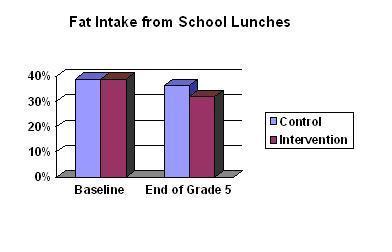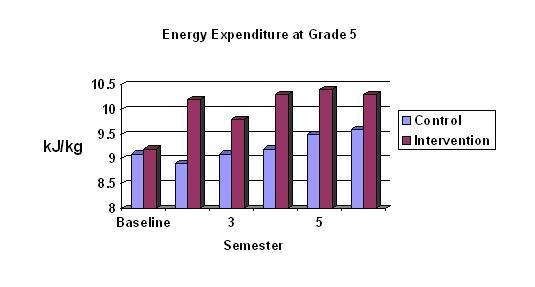Program Synopsis
Designed to improve dietary habits and increase physical activity among children and adolescents, this intervention consists of school components (such as a curriculum, physical education, and school food service modifications) and family components (such as a home curriculum and family fun nights) that work together to address nutrition, physical activity, and cigarette smoking. The study showed a decrease in fat intake from school lunches and an increase in energy expenditure.
Program Highlights
Program Materials
Preview and order the materials from the developer
Program Scores
The Need
Epidemiological data link cancer and other chronic diseases to such health behaviors as lack of vigorous and regular physical activity, over-consumption of food, especially high fat food, and smoking tobacco. Evidence suggests that these behaviors are often learned in childhood, which is when the physiological antecedents of cancer, cardiovascular disease, and other adult chronic diseases are established. Population-wide prevention strategies aimed at young people and complemented by interventions for those at elevated risk are widely recommended.
The Program
Coordinated Approach to Child Health (CATCH) aims to prevent chronic disease among young people by using a multi-component behavioral health intervention to be delivered over grades 3, 4, and 5, to students of diverse communities. CATCH consists of school-based (school food service, physical education, and classroom curricula) and family-based (home curricula, family fun nights) components that work together to decrease consumption of fatty and salty foods and increase rigorous physical activity. The classroom and home curricula are implemented by classroom teachers over a fixed time period during each school year, and address eating habits (grades 3 through 5), physical activity (grades 4 and 5), and cigarette smoking (grade 5 only).
Community Preventive Services Task Force Finding
 This program uses an intervention approach recommended by the Community Preventive Services Task Force: enhanced school-based physical education interventions (Physical Activity). This program also uses the following intervention approaches for which the Community Preventive Services Task Force finds insufficient evidence: classroom-based health education interventions focused on providing information (Physical Activity), family-based social support interventions (Physical Activity) and school-based programs promoting nutrition and physical activity (Diet/Nutrition). Insufficient evidence means the available studies do not provide sufficient evidence to determine if the intervention is or is not effective. This does not mean that the intervention does not work. It means that additional research is needed to determine whether the intervention is effective.
This program uses an intervention approach recommended by the Community Preventive Services Task Force: enhanced school-based physical education interventions (Physical Activity). This program also uses the following intervention approaches for which the Community Preventive Services Task Force finds insufficient evidence: classroom-based health education interventions focused on providing information (Physical Activity), family-based social support interventions (Physical Activity) and school-based programs promoting nutrition and physical activity (Diet/Nutrition). Insufficient evidence means the available studies do not provide sufficient evidence to determine if the intervention is or is not effective. This does not mean that the intervention does not work. It means that additional research is needed to determine whether the intervention is effective.Time Required
Grade 3 curricula consists of 15 lessons, delivered over 5 weeks; Grade 4 curricula consists of 24 lessons, delivered over 12 weeks; and Grade 5 curricula consists of 16 lessons, delivered over 8 weeks. Each lesson is approximately 30 to 40 minutes in length. A total of 19 activity packets are sent home for parents and children to complete together over the course of 3 years. For the study, teachers, Physical Education (PE) specialists, and food service personal were required to attend individualized 1 to 1.5 days of training during each of the 3 years.
Intended Audience
Participants were in Grade 3 at baseline (mean age 8.76 years), represented ethnically diverse backgrounds, and attended public schools in California, Louisiana, Minnesota, and Texas.
Suitable Settings
This intervention is intended for school settings.
Required Resources
The classroom curricula include "The Adventures of a Hearty Heart and Friends", "Go for Health-4", and "Go for Health-5" for grades 3, 4, and 5 respectively. Curricula supplements for Grade 4 and 5; the guide for school food service staff; a PE guidebook and grade specific activity boxes to enhance PE activities; and the CATCH Kids Activity Box for the after school component are also required. Additionally, F.A.C.T.S for Five, a four-session tobacco use prevention curriculum and a home activity curriculum are required. Costs associated with the program's implementation are not provided.
About the Study
Schools from four states, including California, Louisiana, Minnesota, and Texas, were randomized to either intervention (56 schools) or control conditions (40 schools). The intervention schools were further randomized into two equal subgroups with one group receiving a school-based program consisting of school food service modifications, PE interventions, and the CATCH curricula, while the other subgroup received the same school-based program plus a family-based program. Schools in the control group received the usual health curriculum, PE, and food service programs. The food service intervention, Eat Smart, provided students with tasty meals that were lower in total fat, saturated fat, and sodium. The PE intervention sought to increase the amount of moderate-to-vigorous physical activity during PE classes to 40% of the PE class time. School food service changes and PE enhancement were continuous programs during the 3 school years.
The classroom curricula targeted psychosocial factors and involved skills development focused on eating behaviors and physical activity patterns with a tobacco use prevention curriculum implemented in Grade 5. The home curriculum involved activity packets that complemented the classroom curricula. In addition, during Grades 3 and 4, students and family members attended "family fun night" that consisted of student dance performances, food booths, distribution of recipes, and games.
Students were followed in a longitudinal study 3 years after the end of Grade 5 (first follow up).
Results indicated:
- At first follow-up, the percentage of energy intake from total fat from school lunches was reduced in the intervention school compared to control school lunches (p < 0.001).

- At first follow-up and at the school level, time spent on moderate-to-vigorous and vigorous activity during PE class increased in intervention schools compared to control schools (p < 0.02) as shown by higher expenditures of energy (kJ/kg). At the individual level, students in the intervention groups reported more daily vigorous activity than control students (p < 0.003). At 3-year follow-up, these gains diminished slightly; however, compared to the control students, intervention students still reported more daily rigorous activity (p < 0.001).

- At first follow-up and at the individual level, fat intake was reduced by 2.4% among students in intervention schools compared to 0.3% for students in control schools (p < .001). At 3-year follow-up these between group differentials were maintained.
- At 3-year follow-up, intervention students continued to have increased dietary knowledge and intentions, compared to control students.
- At first follow-up and 3-year follow-up, blood pressure, body size, and cholesterol measures did not differ between the two groups.
Publications
Perry CL, Lytle La, Feldman H, Nicklas T, Stone E, Zive M, Garceau A, Kelder SH. (1998). Effects of the Child and Adolescent Trial for Cardiovascular Health (CATCH) on Fruit and Vegetable Intake. Journal of Nutrition Education & Behavior, 30, 354-360.


